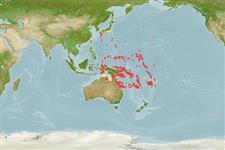Actinopterigi (pesci con pinne raggiate) >
Pleuronectiformes (Flatfishes) >
Soleidae (Soles)
Etymology: Aseraggodes: Greek, aggos, -eos, -ous = vessel, uterus, carapace of a crab + Greek, aseros, -a, -on = to remove the appetite (Ref. 45335).
Ambiente / Clima / Range
Ecologia
; marino associati a barriera corallina; distribuzione batimetrica 0 - 37 m (Ref. 57560). Tropical, preferred ?; 35°N - 23°S, 130°E - 175°W
Pacific Ocean: Marshall Islands and Society Islands.
Size / Peso / Age
Maturity: Lm ? range ? - ? cm
Max length : 4.0 cm SL maschio/sesso non determinato; (Ref. 1602)
Short description
Morfologia | Morfometria
Raggi dorsali molli (totale): 71-78; Raggi anali molli: 48 - 53; Vertebre: 36 - 38. Diagnosis. Dorsal rays 71-78; anal rays 48-53; pelvic rays 5 (3 in one side on one aberrant specimen); caudal rays 18, 14 branched (17 rays, 13 branched in one specimen). Lateral-line scales 77-86, including 10-12 anterior to a vertical at upper end of gill opening). Most scales of ocular side of body with 8-10 cteni (up to 11 on largest specimens); narrowest interorbital space with 2 scales; eyes with only I or 2 scales extending onto medial edge, and only about 3 rows anteriorly. Vertebrae 36-38; dorsal pterygiophores anterior to fourth neural spine 14-15. Body depth 2.55-2.75 in SL; head length (HL) 4.1-4.35 in SL. An overhanging fleshy snout, the lower edge of upper lip usually extending ventral to lower lip and jutting anterior to profile of head below mouth (more evident in smaller specimens); eye diameter 4.7-5.55 in HL; upper eye varying from one-half to full eye diameter anterior to lower eye; interorbital space very narrow, the vertical distance separating eyes less than half eye diameter. Caudal peduncle present, its length 7.2-10.0 in HL. Ventral edge of head posterior to mouth with 10-19 lappet-like cirri; edge of operculum at gill opening with slender well-spaced cirri on both sides; edge of lengthwise membranous ridges of dorsal and anal rays of ocular side with cirri, reduced and disappearing on about posterior half of fins; cirri also present on rays of blind side, but fewer and restricted to more anterior rays. Lateral line aligned with dorsal edge of upper eye; upper end of gill opening in line with ventral fleshy edge of lower eye; anterior nostril reaching fleshy base of lower eye when laid back. Caudal fin slightly pointed, its length 3.05-3.65 in SL; longest dorsal ray 1.4-1.8 in HL; anal rays and all but anterior dorsal rays of larger specimens branched distally; pelvic fins long 1.65-1.85 in HL, the tip of longest ray extending to base of third or fourth anal ray. Color in alcohol of ocular side of most specimens pale tan without any dark markings; American Samoan specimens with faint dark blotches in 3 rows on the ocular side, one row below base of dorsal fin, one along lateral line and one above base of anal fin; yellowish tan with many irregular pale markings partially outlined with dusky brown; fins pale with dusky specks (Ref. 57560).
A single specimen collected from a lagoon coral head at Rongerik Atoll, at a depth of 6 m (Ref. 1602).
Life cycle and mating behavior
Maturità | Riproduzione | Deposizione | Uova | Fecundity | Larve
Myers, R.F., 1991. Micronesian reef fishes. Second Ed. Coral Graphics, Barrigada, Guam. 298 p. (Ref. 1602)
IUCN Red List Status (Ref. 115185)
CITES (Ref. 94142)
Not Evaluated
Threat to humans
Harmless
Human uses
Informazioni ulteriori
Nomi ComuniSinonimiMetabolismoPredatoriEcotossicologiaRiproduzioneMaturitàDeposizioneFecundityUovaEgg development
Age/SizeAccrescimentoLength-weightLength-lengthLength-frequenciesMorfometriaMorfologiaLarveDinamica popolazioni larvaliReclutamentoAbbondanza
BibliografiaAcquacolturaProfilo di acquacolturaVarietàGeneticaFrequenze allelicheEreditarietàMalattieElaborazioneMass conversion
CollaboratoriImmaginiStamps, CoinsSuoniCiguateraVelocitàModalità di nuotoArea branchialeOtolithsCervelliVista
Strumenti
Special reports
Download XML
Fonti Internet
